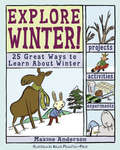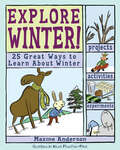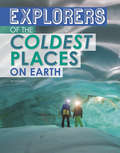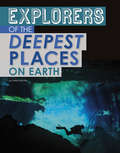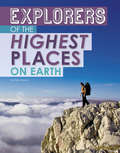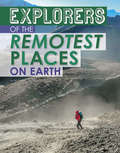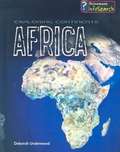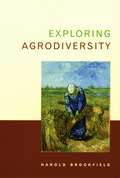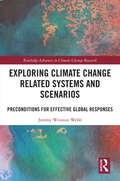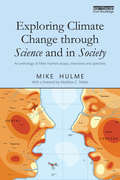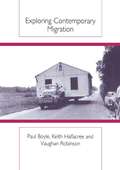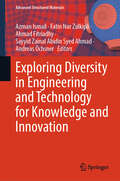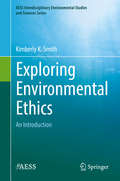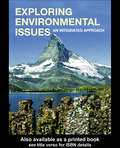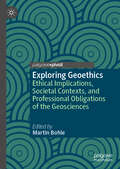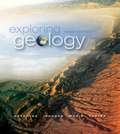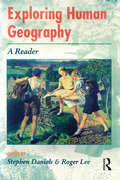- Table View
- List View
Explore Winter!
by Maxine Anderson Alexis Frederick-FrostYoung readers become scientists in the field when this activity book sends them off to answer the question "Why do we have winter?" with experiments and projects that mix real science with real fun. Combining hands-on learning with trivia, jokes, riddles, and terrific illustrations, chapters start with the "tools" of science-the scientific method and how to keep a science journal-and then investigate the winter constellations, long nights and long shadows, animal tracking in snow, and food-gathering behavior in birds.
Explore Winter!: 25 Great Ways to Learn About Winter
by Maxine Anderson Alexis Frederick-FrostYoung readers become scientists in the field when Explore Winter! sends them off to answer the question "Why do we have winter?" with experiments and projects that mix real science with real fun. Combining hands-on learning with trivia, jokes, riddles, and terrific illustrations, chapters start with the "tools" of science-the scientific method and how to keep a science journal-and then investigate the winter constellations, long nights and long shadows, animal tracking in snow, and food-gathering behavior in birds.
Explore the Salish Sea: A Nature Guide for Kids
by Joseph K. Gaydos Audrey DeLella BenedictFilled with beautiful photography and engaging text, Explore the Salish Sea inspires children to explore the unique marine ecosystem that encompasses the coastal waters from Seattle's Puget Sound up to the Strait of Juan de Fuca and the Georgia Strait of British Columbia.Discover the Salish Sea and learn about its vibrant ecosystem in this engaging non-fiction narrative that inspires outdoor exploration. Filled with full-color photography, this book covers wildlife habitats, geodiversity, intertidal and subtidal sea life, and highlights what is unique to this Pacific Northwest ecosystem.
Explorers of the Coldest Places on Earth (Extreme Explorers)
by Nel YomtovFor many decades, courageous men and women have ventured to our planet's foreboding icy regions. These brave explorers risk life and limb in the name of science or for the thrill of adventure. Who are these thrill seekers and why do they do it? Turn the pages to find out!
Explorers of the Deepest Places on Earth (Extreme Explorers)
by Peter MavrikisDid you know the deepest parts of the ocean are still largely unexplored? Courageous explorers risk their lives to go to these great ocean depths. Other explorers journey into deep volcanoes, caves, and mines. Who are they and why are they seeking a glimpse of the world deep below the earth's surface? Turn the pages to find out!
Explorers of the Highest Places on Earth (Extreme Explorers)
by Peter MavrikisThe amount of available oxygen at the highest place on Earth is just under 7%. Explorers risk their lives and test their lungs traveling to these great heights atop mountains. Who are these adventurers and why do they do it? Turn the pages to find out!
Explorers of the Remotest Places on Earth (Extreme Explorers)
by Nel YomtovOf all the places to explore on Earth, remote places are often said to be the most challenging. Yet brave explorers travel to the most remote corners of the world, pushing through vast forests, icy polar regions, and other landscapes. Who are these adventurers and why do they do it? Turn the pages to find out!
Explorers: Amazing Tales of the World's Greatest Adventures (DK Explorers)
by Nellie HuangLive and see the world through the eyes of 50 of the world's greatest explorers and their trusty companions!This book for kids is brimming with first-person accounts of gripping adventures in explorers' own words. Find exciting tales complemented by rare maps, specially commissioned photographs, and artworks that re-create history's greatest expeditions. Get ready to take a leap into the unknown…An adventure book that will surely rival even the most thrilling adventure movies! You'll meet some of the most famous explorers and adventurers of all time in this exciting non-fiction storybook for children. Great explorers have one thing in common - a desire to leap into the unknown, no matter the dangers it presents. This book will take you through Ferdinand Magellan's first circumnavigation of the world 500 years ago to Barbara Hillary's treks to the North and South poles while in her seventies, and beyond. This knowledge book documents the stories of men and women who rewrote our understanding of the world and inspired us by pushing the boundaries of human capability.A kid's educational book that looks at the towering achievements of more than 50 explorers from all walks of life in great detail. See sensational cross-sections revealing the amazing detail inside Spanish galleons, lost cities, and spaceships. Magnificent photographs highlight the artifacts and relics they found along the way, while hand-drawn maps reveal their intrepid journeys in such detail, you feel as though you could be walking in their very footsteps. It is a glorious introduction to history's most famous trailblazers - people whose courage opened frontiers turned voids into maps, forged nations, connected cultures, and added to humankind's knowledge of the world by leaps and bounds. Packed with jaw-dropping fun facts about the world and written so beautifully it will get your heart racing. Explorers is the perfect kid's book for any young mind with an avid sense of adventure! Explore Unknown Waters – Take To The Skies – Investigate Our Planet!For centuries, explorers have been unable to resist the secrets of the sea. We have looked toward the skies and stars since the beginning of time. Through dense jungles, dry desserts, and frozen mountains we have pushed the very limits of human endurance in the name of exploration and adventure! These tales are not for the faint of heart - these adventurers faced challenges that threatened their very survival! Their courage has allowed us to collect a wealth of knowledge about our awe-inspiring universe.Set sail to faraway frozen lands, defy gravity and take to the skies, and investigate our planet through the stories of those who came before us. Happy exploring!Learn about the explorers who defied the so-called possibilities of their time in: - Sea & Ice- Air & Space- And Land
Exploring Africa
by Deborah UnderwoodThis book asks the questions that young people want answered about the continent of Africa. Each chapter of this book contains the answers to a different question about Africa. This book includes clear and detailed maps to assist readers in their quest for knowledge. Explanations are given to help students understand a range of issues in Africa.
Exploring Agrodiversity (Issues, Cases, and Methods in Biodiversity Conservation)
by Harold BrookfieldSmall farmers are often viewed as engaging in wasteful practices that wreak ecological havoc. Exploring Agrodiversity sets the record straight: Small farmers are in fact ingenious and inventive and engage in a diverse range of land-management strategies, many of them resourcefully geared toward conserving resources, especially soil. They have shown considerable resilience in the face of major onslaughts against their way of life by outsiders and government.Using case studies from Africa, Asia, Latin America, and the Pacific, this book provides in-depth analysis of agricultural diversity and explores its history. The book also considers the effect of the "gene revolution" on small farmers and reviews the effects of the "green revolution" in Asian countries. In conclusion, it questions whether the diverse agricultural practices employed by small farmers can survive modern pressures and the global ambitions of the biotechnology industry.
Exploring Caves (F&P Benchmark Assessment System 1 #Level N, Nonfiction)
by Kelley GalipeauExploring Caves Author: Kelley Galipeau
Exploring Caves (Into Reading, Level T #33)
by Jill BryantNIMAC-sourced textbook <p><p> Caves are dark, mysterious places. They are found all around the world, and they can be exciting places to explore. Find out about the deepest cave ever explored, the oldest paintings found on cave walls, and a cave that was used as a school!
Exploring Chemical Concepts Through Theory and Computation
by Shubin LiuExploring Chemical Concepts Through Theory and Computation Deep, theoretical resource on the essence of chemistry, explaining a variety of important concepts including redox states and bond types Exploring Chemical Concepts Through Theory and Computation provides a comprehensive account of how the three widely used theoretical frameworks of valence bond theory, molecular orbital theory, and density functional theory, along with a variety of important chemical concepts, can between them describe and efficiently and reliably predict key chemical parameters and phenomena. By comparing the three main theoretical frameworks, readers will become competent in choosing the right modeling approach for their task. The authors go beyond a simple comparison of existing algorithms to show how data-driven theories can explain why chemical compounds behave the way they do, thus promoting a deeper understanding of the essence of chemistry. The text is contributed to by top theoretical and computational chemists who have turned computational chemistry into today’s data-driven and application-oriented science. Exploring Chemical Concepts Through Theory and Computation discusses topics including: Orbital-based approaches, density-based approaches, chemical bonding, partial charges, atoms in molecules, oxidation states, aromaticity and antiaromaticity, and acidity and basicityElectronegativity, hardness, softness, HSAB, sigma-hole interactions, charge transport and energy transfer, and homogeneous and heterogeneous catalysisElectrophilicity, nucleophilicity, cooperativity, frustration, homochirality, and energy decompositionChemical concepts in solids, excited states, spectroscopy and machine learning, and catalysis and machine learning, as well as key connections between related concepts Aimed at both novice and experienced computational, theoretical, and physical chemists, Exploring Chemical Concepts Through Theory and Computation is an essential reference to gain a deeper, more advanced holistic understanding of the field of chemistry as a whole.
Exploring Climate Change Related Systems and Scenarios: Preconditions for Effective Global Responses (Routledge Advances in Climate Change Research)
by Jeremy Winston WebbJeremy Webb draws on multiple disciplines to piece together the climate change puzzle, identifying what it would take to limit climate change and its impacts.The book starts with a summary of the climate change problem and develops a Climate Change, National Interests, International Cooperation (CCNIIC) model of the climate response system. Webb reviews ‘reverse stress testing’, ‘backcasting’, and ‘theory of change’ methods, showing how they can be used to collect a large sample of possible futures. He also shows how we can explore the multiverse of futures using a new method called thematic chain analysis, finding relevant connections across scenarios. In the second half of the book, Webb explores 175 scenarios collected through 27 interviews with climate change experts. From these scenarios a signal response model is developed. Preconditions for effective social change and behaviour, political will and policy, as well as business and economic activity are synthesised. Lessons include preconditions for effective global responses to climate change, showing what it takes to limit climate change and related impacts. The book finishes with an epilogue, applying the signal response model and preconditions for effective global responses to COVID-19, demonstrating that models from this book can be applied to other global response problems – and used to quickly assess possible response strategies.This book will be of great interest to students and scholars of climate change, environmental policy and future studies.
Exploring Climate Change through Science and in Society: An anthology of Mike Hulme's essays, interviews and speeches
by Mike HulmeMike Hulme has been studying climate change for over thirty years and is today one of the most distinctive and recognisable voices speaking internationally about climate change in the academy, in public and in the media. The argument that he has made powerfully over the last few years is that climate change has to be understood as much as an idea situated in different cultural contexts as it is as a physical phenomenon to be studied through universal scientific practices. Climate change at its core embraces both science and society, both knowledge and culture. Hulme’s numerous academic and popular writings have explored what this perspective means for the different ways climate change is studied, narrated, argued over and acted upon. Exploring Climate Change through Science and in Society gathers together for the first time a collection of his most popular, prominent and controversial articles, essays, speeches, interviews and reviews dating back to the late 1980s. The 50 or so short items are grouped together in seven themes - Science, Researching, Culture, Policy, Communicating, Controversy, Futures - and within each theme are arranged chronologically to reveal changing ideas, evidence and perspectives about climate change. Each themed section is preceded with a brief introduction, drawing out the main issues examined. Three substantive unpublished new essays have been specially written for the book, including one reflecting on the legacy of Climategate. Taken as a collection, these writings reveal the changes in scientific and public understandings of climate change since the late 1980s, as refracted through the mind and expression of one leading academic and public commentator. The collection shows the many different ways in which it is necessary to approach the idea of climate change to interpret and make sense of the divergent and discordant voices proclaiming it in the public sphere.
Exploring Contemporary Migration
by Paul Boyle Keith Halfacree Vaughan RobinsonExploring Contemporary Migration provides the first comprehensive introduction to the various aspects of population migration in both the developed and the developing worlds. Some of the most important quantitative and qualitative methods used for the description and analysis of migration are presented in a clearly structured and accessible way. The various theoretical approaches used to explain the complex patterns of migration are also summarised. These patterns are then explored through the use of specific migration-related themes: employment, stage in the life course, quality of life, societal engineering, violence and persecution, and the role of culture.Exploring Contemporary Migration is written in a user-friendly, accessible style, appealing to undergraduate students of population geography and social science students taking a population module. This text will also be valuable reading to those researchers and academics concerned with gaining a broad understanding of the dynamics and patterns of contemporary population.
Exploring Creation with Earth Science
by Rachael YunisLet’s dig in the dirt, not just talk about it. What is it? How did it get made? Why is it different depending on where you dig? What will you find living in it? <p><p> Let’s realize that we don’t get deliveries from outer space so everything we need, literally everything, is given to us and made fresh with the systems created to keep life forms alive throughout time. How does the Earth replenish its resources again, and again, and again? Join us in Exploring Creation with Earth Science and find out! <p><p> Your young explorer will begin this course with an overview of our cosmic address in the observable universe and then grow in knowledge of what, in the entire universe, makes Earth special and capable of sustaining life. <p><p> An awareness of the world will develop as students interact with the Earth’s geosphere, hydrosphere, atmosphere, and biosphere. By digging deeper into the many different layers of the Earth and the cycles that renew the face of the Earth, your student will acquire not only wisdom that will endure for a lifetime but also an appreciation for our Creator.
Exploring Diversity in Engineering and Technology for Knowledge and Innovation (Advanced Structured Materials #215)
by Andreas Öchsner Azman Ismail Fatin Nur Zulkipli Ahmad Fitriadhy Sayyid Zainal Abidin Syed AhmadThis book offers research result which covers a wide range of topics, including sediment transportation in rivers, efficient adsorption processes, renewable energy, structural resilience, and environmental studies. Researchers explore various areas, including the stability of fishing vessels, the impact of mining on riverbeds, traditional navigation methods, medical procedures, advanced materials, and the utilization of artificial intelligence in data analysis. These comprehensive papers also address structural analysis, chloride-induced damage assessment, and the potential of soy biodiesel in marine engines. It concludes with discussions on probabilistic models, sustainable aquaculture, planning for renewable energy, and the integration of technology in environmental monitoring. This diverse compilation underscores the unwavering pursuit of knowledge and innovation across scientific and engineering disciplines, offering promise for a brighter and more technologically advanced future.
Exploring Environmental Ethics: An Introduction (Aess Interdisciplinary Environmental Studies And Sciences Ser.)
by Kimberly K. SmithThis book is designed as a basic text for courses that are part of an interdisciplinary program in environmental studies. The intended reader is anyone who expects environmental stewardship to be an important part of his or her life, as a citizen, a policy maker, or an environmental management professional. In addition to discussing major issues in environmental ethics, it invites readers to think about how an ethicist's perspective differs from the perspectives encountered in other environmental studies courses. Additional topics covered include corporate social responsibility, ecological citizenship, property theory, and the concept of stewardship as a vocation.
Exploring Environmental Issues: An Integrated Approach
by David D. KempGlobal warming, ozone depletion, drought, acid rain - their causes are viewed as extraordinarily complex; their effects are assumed catastrophic. Exploring Environmental Issues provides a key to understanding our potential crisis. The concise, introductory text presents a review of current environmental issues using a geographical approach that stresses the interrelationships between environment and societies.This user-friendly volume is an essential book for students and all who are concerned with the nature of contemporary environmental issues. Information is presented in a refreshing manner utilising over 170 figures and 50 photographs. Global boxed case studies are used throughout to highlight and explore issues in more detail. The text also contains discussion points, annotated further reading and an extensive glossary.
Exploring Geoethics: Ethical Implications, Societal Contexts, and Professional Obligations of the Geosciences
by Martin BohleThis book explores the potential of geoethics, as designed within the operational criteria of addressing the deeds and values of the human agent as part of the Earth system. It addresses three key questions: i) what should be considered 'geoethics' in an operational sense, ii) what is peripheral to it, and iii) is there a case therefore to establish a denomination, such as geo-humanities or geosophy, to capture a broader scope of thinking about geoscience and its interactions with society and the natural world, for the benefit of the geo-professionals and others.The book begins by framing, contextualising and describing contemporary geoethics, then goes on to cover several examples of geoethical thinking and explores the societal intersections of geosciences in the planetary ‘human niche’. The concluding chapter discusses the challenges facing the emerging field of geoethics and how it may evolve in the future. Bringing together a set of experts across multiple interdisciplinary fields this collection will appeal to scholars, researchers, practitioners and students within geosciences and social sciences, political sciences as well as the humanities. It will interest those who are curious about how ethical reflections relate to professional duties, scholarly interests, activities in professional geoscience associations, or responsible citizenship in times of anthropogenic global change.
Exploring Geology (Third Edition)
by Stephen Reynolds Charles M. Carter Julia Johnson Paul MorinExploring Geology by Reynolds/Johnson/Kelly/Morin/Carter is an innovative textbook intended for an introductory college geology course, such as Physical Geology. This ground-breaking, visually spectacular book was designed from cognitive and educational research on how students think, learn, and study. Nearly all information in the book is built around 2,600 photographs and stunning illustrations, rather than being in long blocks of text that are not articulated with figures. These annotated illustrations help students visualize geologic processes and concepts, and are suited to the way most instructors already teach. To alleviate cognitive load and help students focus on one important geologic process or concept at a time, the book consists entirely of two-page spreads organized into 19 chapters. Each two-page spread is a self-contained block of information about a specific topic, emphasizing geologic concepts, processes, features, and approaches. These spreads help students learn and organize geologic knowledge in a new and exciting way. Inquiry is embedded throughout the book, modeling how geologists investigate problems. The title of each two-page spread and topic heading is a question intended to get readers to think about the topic and become interested and motivated to explore the two-page spread for answers. Each chapter is a learning cycle, which begins with a visually engaging two-page spread about a compelling geologic issue. Each chapter ends with an Investigation that challenges students with a problem associated with a virtual place. The world-class media, spectacular presentations, and assessments are all tightly articulated with the textbook. This book is designed to encourage students to observe, interpret, think critically, and engage in authentic inquiry, and is highly acclaimed by reviewers, instructors, and students.
Exploring High-Temperature Superconductivity in the YBCO System: From Theory to Experiments (SpringerBriefs in Materials)
by Keltoum KhallouqThe book explores the properties and behaviors of high-critical-temperature superconductors in the yttrium barium copper oxide (YBCO) system, looking specifically at Y0.5Ln0.5BaSrCu3O6+z compounds, where Ln represents rare earth elements like europium (Eu), samarium (Sm), and (neodymium) Nd. Structured into several chapters, it navigates through key aspects of superconductivity and its characterization. Starting with an introduction to the discovery of high-critical-temperature superconductors and their far-reaching applications, it sheds light on unresolved questions in materials physics, particularly concerning the behavior of the copper(II)-oxide (CuO2) planes and the introduction of additional electronic holes. Emphasizing the pivotal role of the CuO2 planes in shaping material properties above the critical temperature, it also delves into the history of superconductivity, properties of superconducting materials, and various types of superconductors. Phenomenological theories like the London theory, Ginzburg-Landau theory, and Abrikosov's theory of the mixed state in type II superconductors are discussed, along with conventional theories such as the BCS theory and Josephson junctions. The book provides an overview of experimental techniques used to characterize structural, magnetic, and electrical properties of superconductor compounds, including X-ray diffraction, scanning electron microscopy, and magnetometry. Focusing on the structural, magnetic, and electrical properties of Y0.5Ln0.5BaSrCu3O6+z compounds, along with the effects of substitutions and thermal treatments, the book aims to achieve several objectives. These include a comparative study of superconducting and structural properties under various thermal treatments and isovalent substitutions, analysis of magnetic susceptibility and electrical resistivity as functions of temperature, investigation of the evolution of mixed-state properties with changing temperatures, and utilization of the Rietveld crystallographic refinement method to establish correlations between interatomic distances and critical temperatures. Additionally, the book presents the synthesis of studied compounds through solid-state reactions and subsequent thermal treatments, including annealing under oxygen and argon atmospheres. The results of these treatments are discussed in relation to improvements in irreversibility lines, magnetic shielding, and grain quality.
Exploring Human Geography: A Reader (Arnold Readers in Geography)
by Roger Lee Stephen DanielsA lively and stimulating resource for all first year students of human geography, this introductory Reader comprises key published writings from the main fields of human geography. Because the subject is both broad and necessarily only loosely defined, a principal aim of this book is to present a view of the subject which is theoretically informed and yet recognises that any view is partial, contingent and subject to change.The extracts selected are accessible and raise issues of method and theory as well as fact. The editors have chosen articles that not only represent main currents in the present flow of academic geography but which are also responsive to developments outside of the discipline. Their selection contains a mixture of established and recent writings and each section features a contextualizing introduction and detailed suggestions for further reading.
